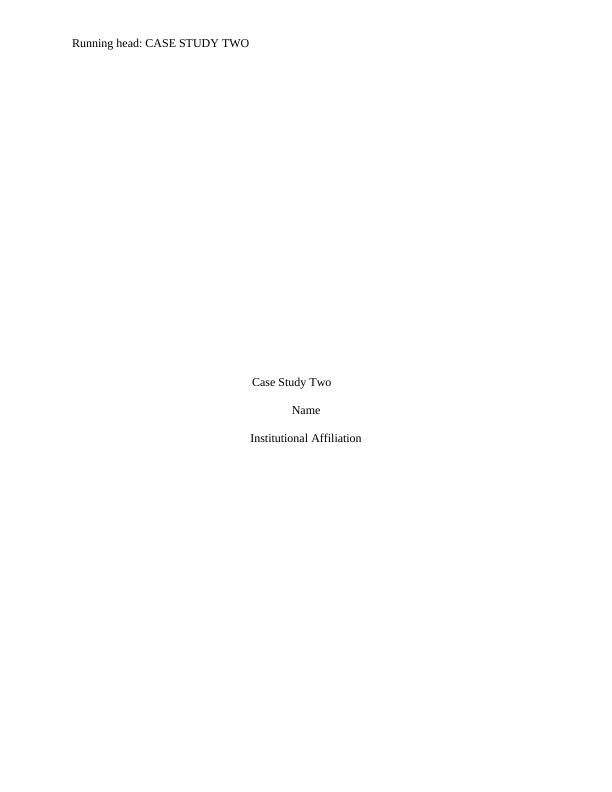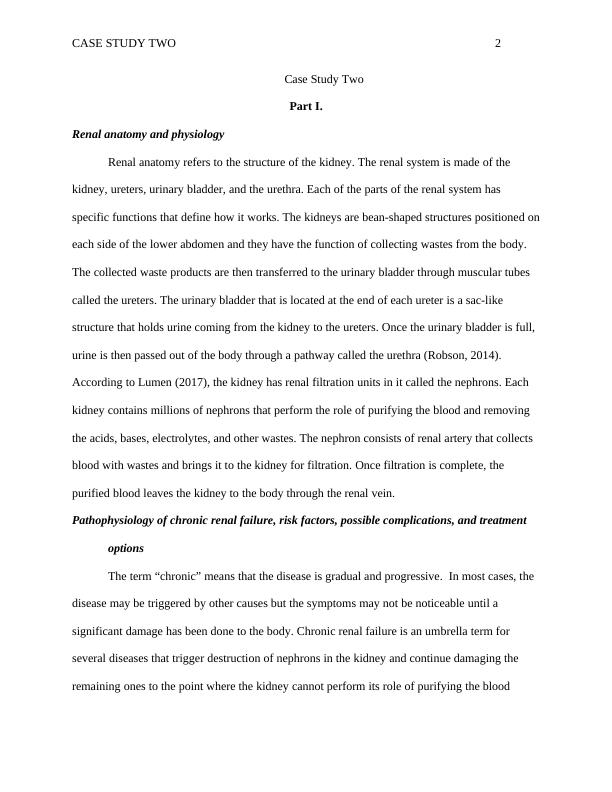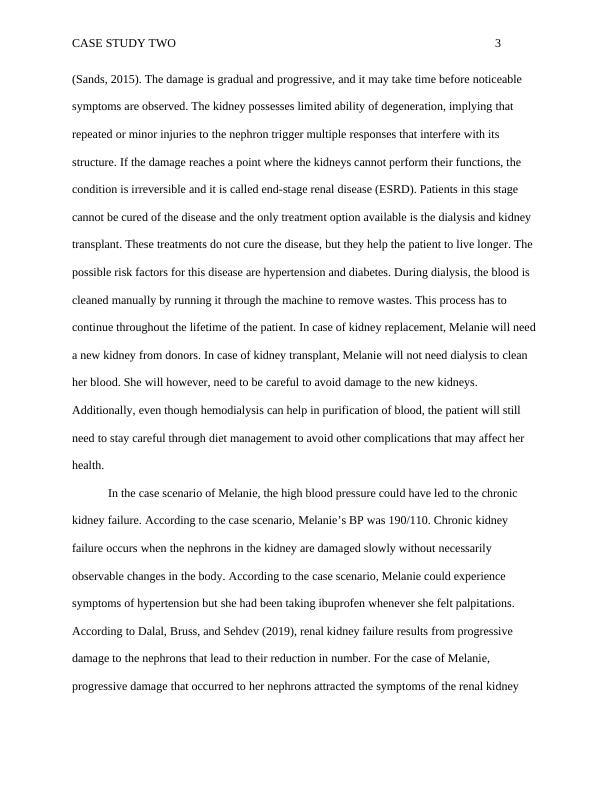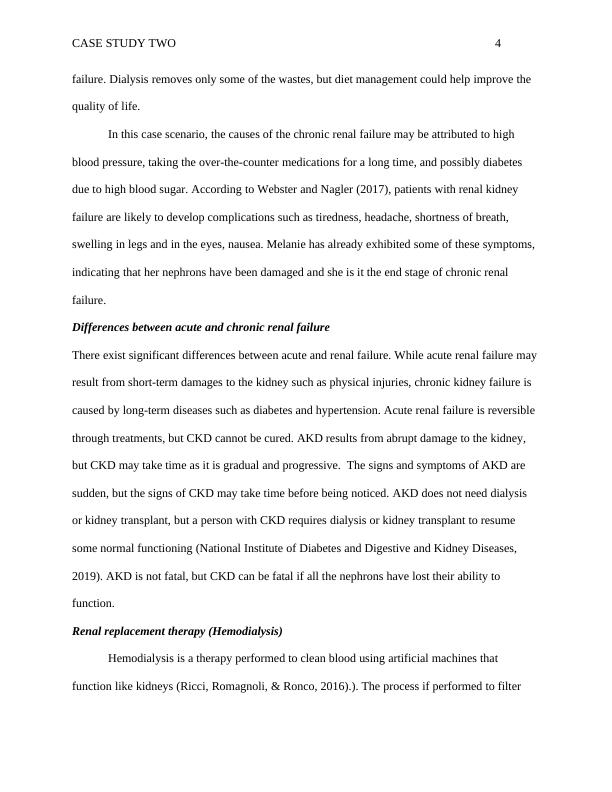Chronic Renal Failure: Pathophysiology, Treatment Options, and Medications
Added on 2022-11-01
11 Pages2815 Words369 Views
Running head: CASE STUDY TWO
Case Study Two
Name
Institutional Affiliation
Case Study Two
Name
Institutional Affiliation

CASE STUDY TWO 2
Case Study Two
Part I.
Renal anatomy and physiology
Renal anatomy refers to the structure of the kidney. The renal system is made of the
kidney, ureters, urinary bladder, and the urethra. Each of the parts of the renal system has
specific functions that define how it works. The kidneys are bean-shaped structures positioned on
each side of the lower abdomen and they have the function of collecting wastes from the body.
The collected waste products are then transferred to the urinary bladder through muscular tubes
called the ureters. The urinary bladder that is located at the end of each ureter is a sac-like
structure that holds urine coming from the kidney to the ureters. Once the urinary bladder is full,
urine is then passed out of the body through a pathway called the urethra (Robson, 2014).
According to Lumen (2017), the kidney has renal filtration units in it called the nephrons. Each
kidney contains millions of nephrons that perform the role of purifying the blood and removing
the acids, bases, electrolytes, and other wastes. The nephron consists of renal artery that collects
blood with wastes and brings it to the kidney for filtration. Once filtration is complete, the
purified blood leaves the kidney to the body through the renal vein.
Pathophysiology of chronic renal failure, risk factors, possible complications, and treatment
options
The term “chronic” means that the disease is gradual and progressive. In most cases, the
disease may be triggered by other causes but the symptoms may not be noticeable until a
significant damage has been done to the body. Chronic renal failure is an umbrella term for
several diseases that trigger destruction of nephrons in the kidney and continue damaging the
remaining ones to the point where the kidney cannot perform its role of purifying the blood
Case Study Two
Part I.
Renal anatomy and physiology
Renal anatomy refers to the structure of the kidney. The renal system is made of the
kidney, ureters, urinary bladder, and the urethra. Each of the parts of the renal system has
specific functions that define how it works. The kidneys are bean-shaped structures positioned on
each side of the lower abdomen and they have the function of collecting wastes from the body.
The collected waste products are then transferred to the urinary bladder through muscular tubes
called the ureters. The urinary bladder that is located at the end of each ureter is a sac-like
structure that holds urine coming from the kidney to the ureters. Once the urinary bladder is full,
urine is then passed out of the body through a pathway called the urethra (Robson, 2014).
According to Lumen (2017), the kidney has renal filtration units in it called the nephrons. Each
kidney contains millions of nephrons that perform the role of purifying the blood and removing
the acids, bases, electrolytes, and other wastes. The nephron consists of renal artery that collects
blood with wastes and brings it to the kidney for filtration. Once filtration is complete, the
purified blood leaves the kidney to the body through the renal vein.
Pathophysiology of chronic renal failure, risk factors, possible complications, and treatment
options
The term “chronic” means that the disease is gradual and progressive. In most cases, the
disease may be triggered by other causes but the symptoms may not be noticeable until a
significant damage has been done to the body. Chronic renal failure is an umbrella term for
several diseases that trigger destruction of nephrons in the kidney and continue damaging the
remaining ones to the point where the kidney cannot perform its role of purifying the blood

CASE STUDY TWO 3
(Sands, 2015). The damage is gradual and progressive, and it may take time before noticeable
symptoms are observed. The kidney possesses limited ability of degeneration, implying that
repeated or minor injuries to the nephron trigger multiple responses that interfere with its
structure. If the damage reaches a point where the kidneys cannot perform their functions, the
condition is irreversible and it is called end-stage renal disease (ESRD). Patients in this stage
cannot be cured of the disease and the only treatment option available is the dialysis and kidney
transplant. These treatments do not cure the disease, but they help the patient to live longer. The
possible risk factors for this disease are hypertension and diabetes. During dialysis, the blood is
cleaned manually by running it through the machine to remove wastes. This process has to
continue throughout the lifetime of the patient. In case of kidney replacement, Melanie will need
a new kidney from donors. In case of kidney transplant, Melanie will not need dialysis to clean
her blood. She will however, need to be careful to avoid damage to the new kidneys.
Additionally, even though hemodialysis can help in purification of blood, the patient will still
need to stay careful through diet management to avoid other complications that may affect her
health.
In the case scenario of Melanie, the high blood pressure could have led to the chronic
kidney failure. According to the case scenario, Melanie’s BP was 190/110. Chronic kidney
failure occurs when the nephrons in the kidney are damaged slowly without necessarily
observable changes in the body. According to the case scenario, Melanie could experience
symptoms of hypertension but she had been taking ibuprofen whenever she felt palpitations.
According to Dalal, Bruss, and Sehdev (2019), renal kidney failure results from progressive
damage to the nephrons that lead to their reduction in number. For the case of Melanie,
progressive damage that occurred to her nephrons attracted the symptoms of the renal kidney
(Sands, 2015). The damage is gradual and progressive, and it may take time before noticeable
symptoms are observed. The kidney possesses limited ability of degeneration, implying that
repeated or minor injuries to the nephron trigger multiple responses that interfere with its
structure. If the damage reaches a point where the kidneys cannot perform their functions, the
condition is irreversible and it is called end-stage renal disease (ESRD). Patients in this stage
cannot be cured of the disease and the only treatment option available is the dialysis and kidney
transplant. These treatments do not cure the disease, but they help the patient to live longer. The
possible risk factors for this disease are hypertension and diabetes. During dialysis, the blood is
cleaned manually by running it through the machine to remove wastes. This process has to
continue throughout the lifetime of the patient. In case of kidney replacement, Melanie will need
a new kidney from donors. In case of kidney transplant, Melanie will not need dialysis to clean
her blood. She will however, need to be careful to avoid damage to the new kidneys.
Additionally, even though hemodialysis can help in purification of blood, the patient will still
need to stay careful through diet management to avoid other complications that may affect her
health.
In the case scenario of Melanie, the high blood pressure could have led to the chronic
kidney failure. According to the case scenario, Melanie’s BP was 190/110. Chronic kidney
failure occurs when the nephrons in the kidney are damaged slowly without necessarily
observable changes in the body. According to the case scenario, Melanie could experience
symptoms of hypertension but she had been taking ibuprofen whenever she felt palpitations.
According to Dalal, Bruss, and Sehdev (2019), renal kidney failure results from progressive
damage to the nephrons that lead to their reduction in number. For the case of Melanie,
progressive damage that occurred to her nephrons attracted the symptoms of the renal kidney

CASE STUDY TWO 4
failure. Dialysis removes only some of the wastes, but diet management could help improve the
quality of life.
In this case scenario, the causes of the chronic renal failure may be attributed to high
blood pressure, taking the over-the-counter medications for a long time, and possibly diabetes
due to high blood sugar. According to Webster and Nagler (2017), patients with renal kidney
failure are likely to develop complications such as tiredness, headache, shortness of breath,
swelling in legs and in the eyes, nausea. Melanie has already exhibited some of these symptoms,
indicating that her nephrons have been damaged and she is it the end stage of chronic renal
failure.
Differences between acute and chronic renal failure
There exist significant differences between acute and renal failure. While acute renal failure may
result from short-term damages to the kidney such as physical injuries, chronic kidney failure is
caused by long-term diseases such as diabetes and hypertension. Acute renal failure is reversible
through treatments, but CKD cannot be cured. AKD results from abrupt damage to the kidney,
but CKD may take time as it is gradual and progressive. The signs and symptoms of AKD are
sudden, but the signs of CKD may take time before being noticed. AKD does not need dialysis
or kidney transplant, but a person with CKD requires dialysis or kidney transplant to resume
some normal functioning (National Institute of Diabetes and Digestive and Kidney Diseases,
2019). AKD is not fatal, but CKD can be fatal if all the nephrons have lost their ability to
function.
Renal replacement therapy (Hemodialysis)
Hemodialysis is a therapy performed to clean blood using artificial machines that
function like kidneys (Ricci, Romagnoli, & Ronco, 2016).). The process if performed to filter
failure. Dialysis removes only some of the wastes, but diet management could help improve the
quality of life.
In this case scenario, the causes of the chronic renal failure may be attributed to high
blood pressure, taking the over-the-counter medications for a long time, and possibly diabetes
due to high blood sugar. According to Webster and Nagler (2017), patients with renal kidney
failure are likely to develop complications such as tiredness, headache, shortness of breath,
swelling in legs and in the eyes, nausea. Melanie has already exhibited some of these symptoms,
indicating that her nephrons have been damaged and she is it the end stage of chronic renal
failure.
Differences between acute and chronic renal failure
There exist significant differences between acute and renal failure. While acute renal failure may
result from short-term damages to the kidney such as physical injuries, chronic kidney failure is
caused by long-term diseases such as diabetes and hypertension. Acute renal failure is reversible
through treatments, but CKD cannot be cured. AKD results from abrupt damage to the kidney,
but CKD may take time as it is gradual and progressive. The signs and symptoms of AKD are
sudden, but the signs of CKD may take time before being noticed. AKD does not need dialysis
or kidney transplant, but a person with CKD requires dialysis or kidney transplant to resume
some normal functioning (National Institute of Diabetes and Digestive and Kidney Diseases,
2019). AKD is not fatal, but CKD can be fatal if all the nephrons have lost their ability to
function.
Renal replacement therapy (Hemodialysis)
Hemodialysis is a therapy performed to clean blood using artificial machines that
function like kidneys (Ricci, Romagnoli, & Ronco, 2016).). The process if performed to filter

End of preview
Want to access all the pages? Upload your documents or become a member.
Related Documents
Chronic Kidney Failure: Anatomy, Physiology, Risk Factors, and Treatment Optionslg...
|10
|2824
|74
(PDF) Kidney Anatomy and Physiologylg...
|8
|2169
|167
Understanding Renal System and Chronic Kidney Disease: A Case Scenariolg...
|15
|3555
|444
Anatomy and Physiology of Urinary System: A Comprehensive Overviewlg...
|4
|781
|454
Renal Anatomy, Physiology, Pathophysiology, and Treatmentlg...
|11
|2897
|244
Understanding the Urinary System: Anatomy and Functionslg...
|18
|4228
|211
